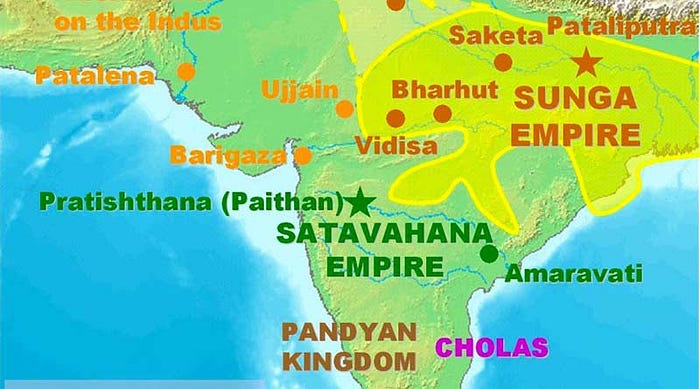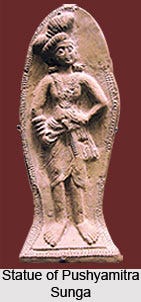The Shunga Dynasty: Unraveling the Legacy of Ancient India
The Shunga dynasty, founded by Pushyamitra Shunga, came to an end in the 1st century BCE. The exact year of its demise is a subject of debate among historians. However, it is generally believed that the Shunga dynasty was overthrown by the Kanvas, another ruling family, around 72 BCE. The Kanvas subsequently took control of the Indian subcontinent and established their own dynasty, bringing an end to the Shunga rule.
After Devabhuti, the last ruler of the Shunga dynasty, was killed by the Kanvas, the fate of his family members is not well-documented in historical records. It is believed that with the downfall of the Shunga dynasty, Devabhuti’s family likely faced significant challenges and may have lost their political power and influence.
The Kanvas, who overthrew the Shungas, established their own dynasty and took control of the Indian subcontinent. It is possible that Devabhuti’s family either went into exile or lived as private citizens without any significant political authority.
Due to the lack of specific historical information, it is difficult to ascertain the exact circumstances or whereabouts of Devabhuti’s family members after his demise. Their story and subsequent fate remain largely unknown in the annals of history.The Sunga dynasty, which ruled ancient India from the 2nd century BCE, does not exist in the present day. The dynasty came to an end with the overthrow of Devabhuti, the last ruler of the Shunga dynasty, by the Kanvas.

After the downfall of the Shunga dynasty and the death of Devabhuti, the last ruler, his family faced a significant shift in their fortunes. They were forced to leave their ancestral lands and political power behind as the Kanvas took control of the region. Devabhuti’s family, however, did not lose the legacy of their Brahmin lineage.
Seeking a fresh start, Devabhuti’s family relocated to the region near the banks of the Ganga in Mirzapur. There, they settled among the local communities, embracing a more humble and ordinary life. Though they no longer held positions of political authority, they continued to maintain their Brahmin traditions and values, preserving their cultural heritage.
Over the passing centuries, Devabhuti’s family thrived as ordinary Brahmins, living a simple yet fulfilling life dedicated to knowledge, spirituality, and serving the community. They became respected figures among the local residents, known for their wisdom and contributions to religious and scholarly pursuits.
Despite their loss of political power, the Devabhuti family retained a deep sense of pride in their lineage as Brahmin rulers. They passed down stories and teachings from generation to generation, ensuring that their rich heritage was not forgotten. Their devotion to learning and their commitment to upholding the principles of righteousness and virtue became their lasting legacy.
The family’s connection to their ancestral roots gradually faded from memory, but their contributions as scholars, priests, and advisors left an indelible mark on the community. Their dedication to education and spiritual guidance served as a guiding light for future generations.
In this way, Devabhuti’s family embraced their new role as Brahmins, continuing the noble traditions and values of their lineage. Their presence in the region near Mirzapur became a testament to the enduring power of knowledge and the significance of carrying forward a legacy, even in the absence of political might.
Vijayshankar Pathak, after leaving his family’s political legacy behind, embarked on a different path in life. He found employment as a regular worker at a paper mill in Ballarpur, where he dedicated himself to his work and supported his family with unwavering dedication. Despite not being involved in politics, he instilled strong values of hard work and integrity in his son, Prakash Pathak.
Prakash Pathak, inspired by his father’s strong work ethic and a desire to serve the community, eventually emerged as a charismatic leader. He joined the Shivsena party and dedicated himself to working closely with the people at the grassroots level. Through his selfless service and ability to connect with the hearts of the people, Prakash gained popularity and respect. His sincerity and dedication earned him the position of Taluka Pramukh, where he played a pivotal role in addressing the concerns and issues of the local community.
Prakash’s son, currently studying at GH Raisoni College of Engineering in Nagpur, carries forward the family’s legacy of serving others. With a strong belief in the power of education and the potential of young minds, he founded the Vidharba Vidhyarthi Sena, a student-helping organization. Through this organization, he focuses on empowering and supporting students in their academic journey, providing mentorship, resources, and guidance to help them excel.
Driven by his passion for education and his commitment to making a positive impact, he actively engages with students, organizing workshops, seminars, and educational initiatives. His vision is to create a conducive environment for students to grow, learn, and succeed, ultimately contributing to the development of their communities and society as a whole.
The Pathak family’s journey demonstrates the transformative power of personal growth and service. From Vijayshankar’s humble beginnings as a paper mill worker to Prakash’s rise to political prominence, and now their son’s pursuit of empowering students, they have each left their mark in different ways. Their dedication to their work, community service, and commitment to making a difference exemplifies the values they hold dear.

- Pushyamitra Shunga (185 BCE — 149 BCE
- Agnimitra (149 BCE — 141 BCE)
- Vasujyeshtha (141 BCE — 131 BCE)
- Vasumitra (131 BCE — 124 BCE)
- Bhagabhadra I (124 BCE — 113 BCE)
- Devabhuti (113 BCE — 73 BCE)
- Devabhuti II (73 BCE — 64 BCE)
- Devabhuti III (64 BCE — 51 BCE)
- Bhagabhadra II (51 BCE — 35 BCE)
- Bhagabhadra III (35 BCE — 27 BCE)
- Bhagabhadra IV (27 BCE — 21 BCE)
- Vasusharma (21 BCE — 12 BCE)
- Agnimitra II (12 BCE — 8 BCE)
- Vasumitra II (8 BCE — 4 BCE)
- Bhagabhadra V (4 BCE — 1 BCE)
- Vasujyeshtha II (1 BCE — 3 CE)
- Devabhuti IV (3 CE — 7 CE)
- Vasujyeshtha III (7 CE — 13 CE)
- Vasumitra III (13 CE — 16 CE)
- Bhagabhadra VI (16 CE — 20 CE)
- Aniketnath (20 CE — 35 CE)
- Harshnath (35 CE — 44 CE)
- Parinath (44 CE — 52 CE)
- Vinaynath (52 CE — 65 CE)
- Rajnath (65 CE — 78 CE)
- Krishnath (78 CE — 90 CE)
- Shivanath (90 CE — 102 CE)
- Arjunanath (102 CE — 115 CE)
- Jaynath (115 CE — 128 CE)
- Siddharthnath (128 CE — 142 CE)
- Maheshnath (142 CE — 157 CE)
- Yoginath (157 CE — 173 CE)
- Chandranath (173 CE — 190 CE)
- Surajnath (190 CE — 208 CE)
- Indranath (208 CE — 227 CE)
- Raghavnath (227 CE — 247 CE)
- Mohannath (247 CE — 268 CE)
- Prabhatnath (268 CE — 290 CE)
- Anandnath (290 CE — 313 CE)
- Shivnath (313 CE — 337 CE)
- Govindnath (337 CE — 362 CE)
- Samarthnath (362 CE — 388 CE)
- Hemnath (388 CE — 415 CE)
- Siddhanath (415 CE — 443 CE)
- Harinath (443 CE — 472 CE)
- Vikramnath (472 CE — 502 CE)
- Abhinath (502 CE — 533 CE)
- Rajnath II (533 CE — 565 CE)
- Anantnath (565 CE — 598 CE)
- Vishwanath (598 CE — 632 CE)
- Vishwanath II (632 CE — 668 CE)
- Shivnath II (668 CE — 706 CE)
- Harinath II (706 CE — 747 CE)
- Vikramnath II (747 CE — 790 CE)
- Abhinath II (790 CE — 835 CE)
- Rajnath III (835 CE — 882 CE)
- Anantnath II (882 CE — 931 CE)
- Vishwanath III (931 CE — 983 CE)
- Shivnath III (983 CE — 1037 CE)
- Harinath III (1037 CE — 1094 CE)
- Vikramnath III (1094 CE — 1154 CE)
- Abhinath III (1154 CE — 1217 CE)
- Rajnath IV (1217 CE — 1283 CE)
- Anantnath III (1283 CE — 1352 CE)
- Vishwanath IV (1352 CE — 1424 CE)
- Shivnath IV (1424 CE — 1500 CE)
- Harinath IV (1500 CE — 1579 CE)
- Vikramnath IV (1579 CE — 1661 CE)
- Abhinath IV (1661 CE — 1746 CE)
- Rajnath V pathak (1746 CE — 1834 CE)
- Ram pathak (1834 CE — 1925 CE)
- kedarnth pathak (1918 CE — 1998CE)
- vijayshankar pathak(1945 CE — 2023 CE)
- Prakash pathak ( 1981CE — 2023CE)
- Aviral Pathak (2005CE — 2023 CE)
Devabhuti (113 BCE — 73 BCE)
